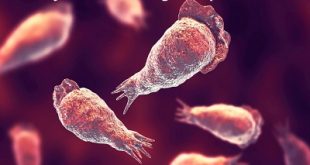Definition
Powassan virus is transmitted to humans by infected ticks. Approximately 60 cases of POW virus disease were reported in the United States over the past 10 years. Most cases have occurred in the Northeast and Great Lakes region. Signs and symptoms of infection can include fever, headache, vomiting, weakness, confusion, seizures, and memory loss. Long-term neurologic problems may occur. There is no specific treatment, but people with severe POW virus illnesses often need to be hospitalized to receive respiratory support, intravenous fluids, or medications to reduce swelling in the brain.
Epidemiology
Powassan disease cases are rare, but infections are endemic in the upper Midwest of the United States, Canada, and far-eastern Russia. It is the only tick-borne virus to be endemic in North America. The cases occur primarily in the late spring, early summer, and mid-fall when ticks are most active due to the warmer weather. The seasonal incidence depends on the activity of tick vectors. The highest incidence is reported in rural or forested areas from June to September. There have only been 21 cases of Powassan disease in Canada since 2017 which means that the risk of the disease is very low in Canada. Males and children are more frequently infected possible because they tend to be more outdoors and up to 27 cases have been reported in North America since 1958.
Powassan virus pathophysiology
The initial stages of the POW virus disease result from viremia that develops in the setting of an infected tick bite. Animal models have shown that infection can occur in as short as 15 minutes after tick attachment. Human studies have validated these observations and have established that infection can occur within three hours of tick attachment. This contrasts the much longer attachment times needed to transmit other common tick-borne infections like Babesia microti, Anaplasma phagocytophilum, and Borrelia burgdorferi. After primary infection occurs, patients can develop non-specific flu-like symptoms that are typically self-limited. Subsequently, days to weeks later, a subset of patients will develop neurologic manifestations that most commonly present as encephalitis or meningoencephalitis. The risk factors and molecular mechanisms underlying the progression from mild symptoms to neuroinvasion remain unclear.
Transmission of Powassan virus
Powassan virus is named for the Ontario town in which it was discovered in Powassan virus a tick-borne disease1958; it is still primarily found in Canada, as well as the United States Great Lakes and northeastern states. The virus is found in small rodents, transmitted to any of six species of ticks that feed on the rodents and then to humans who are bitten by ticks. The virus is not transmitted from person to person. While transmission of Lyme disease may take up to 48 hours after a tick attaches, experts think that Powassan virus transmission could occur within less than 12 hours.
Who is most at risk of the Powassan virus?
It is not known what percentage of the black-legged tick population is infected with the Powassan virus, so it is possible people are at risk of infection anywhere the black-legged tick is found, which includes New Hampshire.
This tick is most active from spring until midsummer and again in the fall. It is believed the risk in New Hampshire is low but people should take precautions against tick bites to prevent all diseases transmitted by ticks, including Lyme disease, which is very common.
Causes of Powassan virus
Powassan virus is a tick-borne flavivirus that causes Powassan disease. The pathogen is enveloped with a single-stranded positive-sense RNA genome. The virus was named after Powassan, Ontario where it was first discovered in 1958. Two types of Powassan virus have been found in North America: Lineage 1 (prototype) and lineage 2 (deer tick virus) Powassan viruses. The 2 lineages are serologically indistinguishable and therefore the part of the same viral species.
Symptoms of Powassan virus
Many people infected with the Powassan virus do not develop any symptoms. For those who do, signs and symptoms usually appear within 1-4 weeks of the bite of an infected tick. Signs and symptoms of Powassan virus disease can include:
- Fever
- Headache
- Vomiting
- Weakness
- Confusion
- Loss of coordination
- Speech difficulties
- Seizures
The most severe cases of Powassan virus disease can include encephalitis (inflammation of the brain) and meningitis (inflammation of the membranes that surround the brain and spinal cord). Among people with severe disease, about half will have permanent complications, such as recurrent headaches, muscle wasting and memory problems. Approximately 10% of severe Powassan virus disease cases are fatal.
Complications
Long-term neurologic problems may occur and can include recurrent headaches, issues with memory, and muscle wasting.
Approximately 10 percent of serious cases that develop encephalitis (inflammation of the brain) caused by Powassan virus disease are fatal.
Diagnosis and test
Healthcare providers diagnose Powassan virus infection based on:
- Signs and symptoms
- History of possible exposure to the ticks that spread Powassan virus
- Laboratory testing of blood or spinal fluid
Treatment and medications
Currently, there is no approved chemoprophylaxis, vaccine, or disease-specific treatment for POW virus infection. Management of patients is supportive and should involve the expertise of an infectious disease specialist.
- General supportive treatment with intravenous fluids, antipyretics, and critical care, as required, have been effective, but the overall case mortality remains high.
- Several case reports have proposed the potential use of high-dose corticosteroids or intravenous immunoglobulin (IVIG).
- However, there are no clinical studies supporting improved clinical outcomes with either agent, and caution should be used if considering their use.
- Data on specific antivirals with activity against POW is also scant, and there are currently no antiviral agents with known efficacy against the POW virus.
Prevention of Powassan virus
The best way to prevent POW virus infection is to prevent tick bites and avoid areas where ticks are likely to be found. In general, you can keep tick numbers low by reducing cover and shade, keeping grass mowed, removing leaf litter, and trimming shrubs and trees. Other precautions to take:
- Wear long-sleeved shirts and long pants and tuck your pant legs into your socks.
- Light-colored clothes can help you spot the ticks on your clothes before they reach your skin.
- Stay to the middle of paths when in a heavily wooded area.
- Use insect repellants approved by the Environmental Protection Agency (EPA).
- Read labels carefully.
- Always check yourself and your children after being to a high risk area to find any ticks that may have attached.
 Diseases Treatments Dictionary This is complete solution to read all diseases treatments Which covers Prevention, Causes, Symptoms, Medical Terms, Drugs, Prescription, Natural Remedies with cures and Treatments. Most of the common diseases were listed in names, split with categories.
Diseases Treatments Dictionary This is complete solution to read all diseases treatments Which covers Prevention, Causes, Symptoms, Medical Terms, Drugs, Prescription, Natural Remedies with cures and Treatments. Most of the common diseases were listed in names, split with categories.







